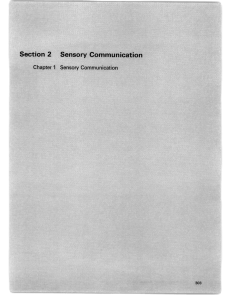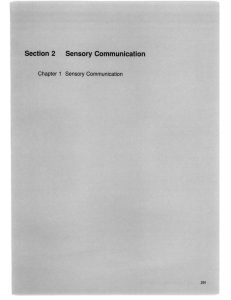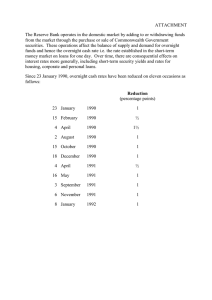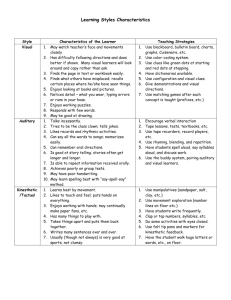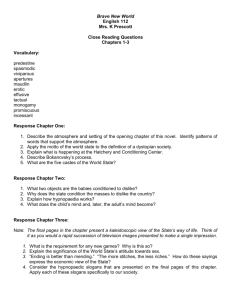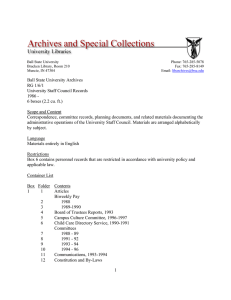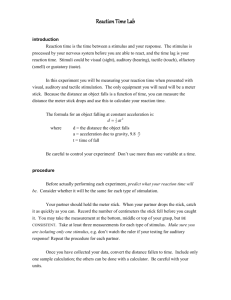Section 2 Sensory Communication 1
advertisement
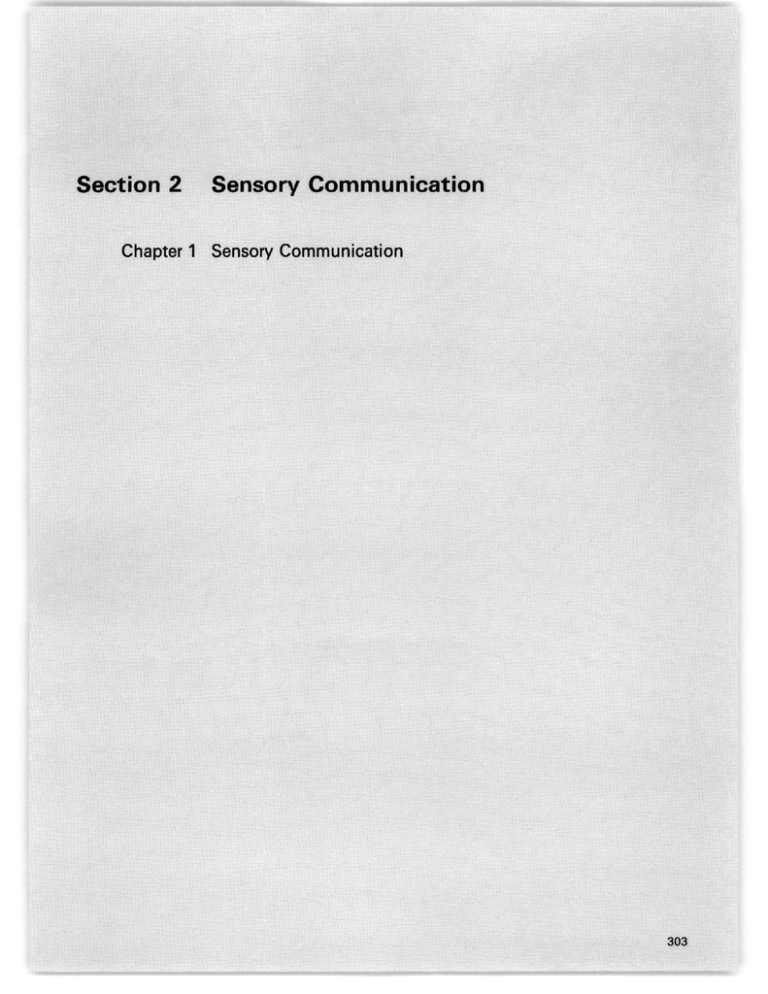
Section 2 Sensory Communication Chapter 1 Sensory Communication 304 RLE Progress Report Number 134 Chapter 1. Sensory Communication Chapter 1. Sensory Communication Academic and Research Staff Professor Louis D. Braida, Professor Richard M. Held, Dr. Joan M. Besing, Lorraine A. Delhorne, Nathaniel I. Durlach, Dr. Donald K. Eddington, Dr. Susan L. Goldman, Seth M. Hall, Dr. Xiao Dong Pang, Dr. William M. Rabinowitz, Dr. Christine M. Rankovic, Dr. Charlotte M. Reed, Dr. Mandayam A. Srinivasan, Dr. Rosalie M. Uchanski, Dr. Victor W. Zue, Dr. Patrick M. Zurek Visiting Scientists and Research Affiliates Dr. Richard L. Freyman, Dr. Kenneth W. Grant, Dr. Janet D. Koehnke, Dr. Jack Kotik, Dr. Neil A. Macmillan, Wei Min, Dr. Karen L. Payton, Dr. Patrick M. Peterson Graduate Students Santosh Ananthraman, Jyh-Shing Chen, Kiran B. Dandekar, Paul Duchnowski, Joseph A. Frisbie, Eric M. Fuchs, Julie E. Greenberg, Wolfgang G. Knecht, Gregory R. Martin, Matthew H. Power, Michael T. Richey, Barbara G. Shinn-Cunningham, Robert W. Stadler, Hong Z. Tan Undergraduate Students Susan E. Bach, Belinda Chen, Swaroop Gantela, Rajashi Ghosh, Andrew H. Grant, Rogeve Gulati, Darby A. Hailes, John M. Hedgcock, Albert G. Hong, Mary A. Hou, Michael H. Lim, Sandra Y. Ma, Alexa Ogno, Prashun R. Patel, Charles A. Reisman, Alexander P. Rigopulos, Diane E. Ronan, Brian A. Rubin, Sumeet Sandhu, Leon L. Ting Technical and Support Staff Ann K. Dix, Eleanora M. Luongo, Timothy J. Stellmach, Michael T. Tuyo 1.1 Introduction The Sensory Communication Group is conducting research on (1) the auditory and tactual senses, (2) auditory, visual, and tactual aids for individuals who are hearing-impaired or deaf, and (3) human-machine interfaces for teleoperator and virtual-environment systems (involving the visual as well as the auditory and tactual senses). Within the domain of hearing aids, research is being conducted on systems that bypass the outer and middle ear and directly stimulate the auditory nerve electrically (cochlear prostheses), as well as on systems that stimulate the ears acoustically. The research on taction is focused not only on speech reception for the totally deaf, but also on the ability of the human hand to sense and manipulate the environment. Within the domain of human-machine interfaces, topics of special interest concern the development of principles for mapping the human sensorimotor system into non-anthropomorphic slave mechanisms (or the equivalent in virtual space) and the ability of the human sensorimotor system to adapt to alterations of normal sensorimotor loops caused by the presence of the interface. 1.2 Hearing Aid Research Dr. Rosalie M. Uchanski, Dr. Victor W. Zue, Dr. Patrick M. Zurek Sponsor This research is directed toward the development of improved hearing aids for people suffering from hearing impairments that cannot be treated medically. Since the major problem for most people with impaired hearing is a degraded ability to understand speech, and since medical treatments are available for abnormalities of the outer and middle ear, our work is directed towards aids that better match speech signals to residual auditory function in people with impairments central to the middle ear. More specifically, the research is National Institutes of Health Grant 5 R01 DC00117 Project Staff Dr. Joan M. Besing, Professor Louis D. Braida, Lorraine A. Delhorne, Paul Duchnowski, Nathaniel I. Durlach, Joseph A. Frisbie, Dr. Susan L. Goldman, Gregory R. Martin, Matthew H. Power, Dr. Christine M. Rankovic, Dr. Charlotte M. Reed, 305 Chapter 1. Sensory Communication directed at improving speech reception for people with sensorineural impairments. The work performed during the past year can be divided into four project areas: linear amplification, speech token variability, prediction of speech intelligibility, and aids to speechreading. 1.2.1 Linear Amplification This research has focused on (1) methods for prescribing and automatically controlling the frequency response of hearing aids, and (2) analysis of perceptual integration of acoustic speech cues Work in the first area has across frequency. included a theoretical analysis of suggested prescriptive methods for fitting frequency-gain characteristics to individual listeners1 and a study of the use of adaptive frequency-gain characteristics to combat the effects of background interference on target speech intelligibility.2 Work is also underway on the development of real-time signalprocessing implementations of systems with adaptive frequency-gain characteristics. In the second area, we have studied the combination of cues arising from various spectral bands of speech and applied models of perceptual integration3 to the analysis of the resulting consonant confusions. 1.2.2 Speech Token Variability Performance in intelligibility tests for speech segments depends on the set of segments to be identified, characteristics of the talker, and the number and variability of the speech tokens chosen to represent a given segment. Speech perception experiments, which systematically controlled the number of tokens for each speech segment, have been completed for American English vowels and for normal hearing listeners. For both vowel identification and discrimination tasks, performance generally is (1) highest when only one token represents each segment and (2) roughly equal when four and sixteen tokens represent each segment. 4 The first result indicates that the use of a single token for each speech segment can lead to the use of artifacts as perceptual cues and to artificially high performance. Two additional experiments are in progress. The first is measuring the effect of number of tokens on vowel identification with cochlear implant users as listeners. The second, a vowel discrimination experiment, was designed so that its results allow development of a relationship between discriminability and previously measured physical attributes of the same vowel segments. 1.2.3 Prediction of Speech Intelligibility This project involves development of computational methods for predicting the intelligibility of speech subjected to a waveform degradation. The approach employs a model of the human auditory system which reduces a speech waveform to a sequence of discrete symbols, each representing a prototypical vector of parameter values measured in a single frame of speech. The perceptual effect of the transformation is estimated by assessing the transmitted information between the symbol sequence derived from an untransformed (input) speech signal and that derived from a transformed (output) speech signal. Current efforts5 are underway to assess the model's ability to predict the effects of linear filtering and additive noise on speech intelligibility. 1 C.M. Rankovic and P.M. Zurek, "Evaluation of Prescriptive Fitting Procedures Using the Al Model," ASHA 33: 164 (1991). 2 C.M. Rankovic, R.L. Freyman, and P.M. Zurek, "Potential Benefits of Varying the Frequency-Gain Characteristic for Speech Reception in Noise," J. Acoust. Soc. Am. 91: 354-362 (1992); C.M. Rankovic, P.M. Zurek, and R.L. Freyman, "Potential Benefits of Varying the Frequency-Gain Characteristic for Speech Reception in Noise for Hearing-Impaired Individuals," J. Acoust. Soc. Am. 90: 2319 (1991); P.M. Zurek, "Interference Reduction for the Hearing Impaired." J. Acoust. Soc. Am. 89: 1957 (1991). 3 L.D. Braida, "Crossmodal 43A(3): 647-677 (1991). 4 R.M. Uchanski, K.M. for Vowel Sounds," L.D. Braida, "Effects Auditory Periphery to Integration in the Identification of Consonant Segments," Quart. J. Exper. Psych. Millier, D.E. Ronan, C.M. Reed, and L.D. Braida, "Effects of Token Variability on Resolution J. Acoust. Soc. Amer. 90(4): 2254 (1991); R.M. Uchanski, K.M. Millier, C.M. Reed, and of Token Variability on Vowel Identification," in The Processing of Speech: From the Word Recognition (Berlin: Mouton de Gruyter, 1992). M.H. Power and L.D. Braida, " A Physical Measure of Consistency Among Speech Parameter Vectors: Application to Speech Intelligibility Determination," J. Acoust. Soc. Am. 90: 2327 (1991). 306 RLE Progress Report Number 134 Chapter 1. Sensory Communication 1.2.4 Aids to Speechreading Our study of aids to speechreading has focused on (1) developing a system for the preparation of audiovisual test stimuli, and (2) evaluating the effectiveness of Cornett's manual Cued Speech system. Our research in this area requires a large corpus of speech materials that can be randomly accessed for presentation in experiments. We have begun to develop an automated facility for recording selected audiovisual recordings onto laser disks, preparing taped audiovisual tests from the laser disks, and randomly accessing recorded segments as required in identification experiments. This facility incorporates a laser-disk recorder/player system that can be operated under computer control. Results obtained with subjects who are highly experienced (8 to 25 years) in the reception of Cued Speech indicate that manually cued speech is much more intelligible than lipread speech, and under typical conversational conditions is received nearly perfectly. Work is currently underway to develop an automatic cueing system capable of generating cues that supplement speechreading as effectively as manually produced cues. Experienced receivers of Cued Speech will be tested on their ability to receive sentence materials in which cues are generated synthetically. Specified error structures will be introduced into the cues to determine the performance that must be achieved by effective automatic cueing systems. 1.3 Multimicrophone Hearing Aids Sponsor National Institutes of Health Grant 5 R01 DC00270 Project Staff Nathaniel I. Durlach, Julie E. Greenberg, Wolfgang G. Knecht, Dr. Xiao Dong Pang, Dr. William M. Rabinowitz, Robert W. Stadler, Dr. Patrick M. Zurek The long-term goal of this research is the development of sensory aids that improve the ability of hearing-impaired listeners to function in complex acoustic environments through the use of microphone arrays. Since the reception of speech is the most important problem for the hearing impaired, the target signal of primary interest is speech. To enhance monaural speech reception, we envision a microphone array that resolves the incoming signals into simultaneous directional channels, followed by a coding operation that transforms these resolved signals in such a way that resolution is preserved at the perceptual level after the signals are summed for presentation to a single ear. 6 Such a system would permit the monaural listener (like the normal binaural listener) to monitor all directions simultaneously, to detect and localize in the same operation, and to focus on a single direction. Our current work on the microphone array is directed toward the creation of a single directional channel containing the target signal (assumed to arise from a target source straight ahead of the listener) and the reduction of interference from sources directionally distinct from the target source. Parallel processing of array outputs to achieve simultaneous multiple directional channels will be considered only after further progress on the coding problem has been achieved. Work during the past year has focused on assessments of modifications to the basic beamforming algorithm and performance in reverberant environments. 1.3.1 Adaptive Beamforming: Controlling Adaptation The adaptive beamforming algorithm that has been the focus of much of our work, the Griffiths-Jim beamformer, 7 can be viewed as a simple preprocessor operating in conjunction with an adaptive noise canceller (ANC). 8 Two of the problems encountered with this beamforming system are associated with, and can be described more simply in terms of, the ANC. The first problem is known as misadjustment and is due to fluctuations in the adaptive filter's weights. The second problem, known as misalignment, comes from leakage of the target signal into the reference channel, which 6 N.I. Durlach, R.C. Corbett, M.V. McConnell, W.M. Rabinowitz, P.M. Peterson, and P.M. Zurek, "Multimicrophone Monaural Hearing Aids," RESNA 10th Annual Conference, San Jose, California, 1987. 7 L.J. Griffiths and C.W. Jim, "An Alternative Approach to Linearly Constrained Adaptive Beamforming," IEEE Trans. Antennas Propag. AP-30: 27-34 (1982). 8 B. Widrow, J.R. Glover, Jr., J.M. McCool, J. Kaunitz, C.S. Williams, R.H. Hearn, J.R. Zeidler, E. Dong, Jr., and R.C. Goodlin, "Adaptive Noise Cancelling: Principles and Applications," Proc. IEEE 63: 1692-1716 (1975). 307 Chapter 1. Sensory Communication is ideally free of the desired target for best estimation of the interfering jammer. Both problems increase in severity with input target-to-jammer We have developed two power ratio (TJR). and power output on (based methods intermicrophone correlation) to control adaptation and reduce the high-TJR problems of misalignment and misadjustment in a two-microphone Griffiths-Jim beamformer. 9 Both methods exploit the fact that speech exhibits a high degree of fluctuation and has pause periods; these methods are attempts to sense the TJR and to adapt only in intervals when the TJR is small. Figure 1 shows the results of computer simulations in an anechoic environment with a speech target and a single jammer for both aligned and misaligned arrays. The by as measured plot shows performance intelligibility-weighted gain from the input to the output of the system, as a function of TJR at the system input. These results demonstrate the effectiveness of both methods for controlling adaptation; together, the two modifications significantly improved performance at high TJRs. 1.3.2 Adaptive Beamforming: Performance in Reverberation We have also considered the effect of reverberation on system performance.10 Initial studies have shown that reverberation degrades performance due to effects associated with both target and jammer. Reverberant target degrades performance by violating the assumption that the target signal Reverberant arrives from a known direction. jammer is cancelled only when it falls within the time span of the adaptive filter, so jammer is cancelled less effectively when the room impulse resFuture work will ponse exceeds that span. consider methods to overcome the problems associated with reverberation. aligned 30 -- misaligned 30 - 20 20 mA -10 o0S0 . -- c1 -.- ------ 0 - - •*power/correlation A power only -10- -- 10 correlation only -20 A no modifications I I I -oo -20 0 20--o Input TJR -20 -20 0 20 (dB) Figure 1. Results of computer simulations showing the effects of adaptation-control methods with a twomicrophone array perfectly aligned and misaligned by 10 degrees. Plots show the gain, G1, in the effective target-to-jammer ratio from input to output of the system, as a function of input target-to-jammer ratio. The environment was anechoic, and the target and jammer were separated by 45 degrees in azimuth. The array was a free-space, 26-cm broadside array. 1.4 Cochlear Prostheses Sponsor National Institutes of Health Grant 5 P01 DC0036111 Project Staff Professor Louis D. Braida, Lorraine A. Delhorne, Dr. Donald K. Eddington, Dr. William M. Rabinowitz The overall goal of this research project is to determine and understand the potential and limitations of cochlear prostheses and to develop improved Residual sensorineural hearing is prostheses. measured prior to implantation in connection with subject selection and to provide baseline data for later comparison. Following implantation, auditory performance is evaluated by studying psychophysical performance, discrimination of speech ele- 9 J.E. Greenberg and P.M. Zurek, "Evaluation of an Adaptive Beamforming Method for Hearing Aids," J. Acoust. Soc. Am., forthcoming. 10 J.E. Greenberg and P.M. Zurek, "Adaptive Beamformer Performance in Reverberation," paper presented at the 1991 IEEE Workshop on Applications of Signal Processing to Audio and Acoustics, Mohonk, New York, October 20-23, 1991. 11 Subcontract from Massachusetts Eye and Ear Infirmary. Dr. Joseph B. Nadol, M.D., Principal Investigator. 308 RLE Progress Report Number 134 Chapter 1. Sensory Communication ments, and comprehension of speech and the acoustic environment. Attempts are made to identify and measure central processing abilities that are relevant to speech-reception performance with an implant and that may help explain the large intersubject variations observed. Also, for comparison purposes, speech-reception tests are performed using a promising multichannel tactile vocoder. To minimize differential learning effects in the comparison, these tests are restricted to discrimination of speech segments. Further research focuses on alternative speech-processing schemes to achieve improved implant performance. This research capitalizes on analytic results from other parts of our research and the direct accessibility of the implanted electrode array (via a percutaneous plug). During the past year, work has focused on evaluation of overall performance using the present Ineraid prosthesis and alternative speech processing for improved implant performance. The latter work is performed with Dr. Donald K. Eddington of RLE and Drs. Joseph Tierney and Marc Zissmann of MIT Lincoln Laboratory, and stems from an ongoing collaboration with colleagues at Duke University and the Research Triangle Institute. Progress in alternative processing 12 is described in Part IV, Section 3, Chapter 1, Auditory Physiology. tionsl 4 that can account for the benefit of sentence context and the relation between word and phoneme recognition. Across the broad range of performance that existed among the subjects, substantial order was observed among measures of speech reception along the continuum from recognition of words in sentences, words in isolation, speech segments, and the retrieval of underlying phonetic features. Correlations exceeded 0.85 among direct and sentence-derived measures of isolated word recognition as well as among direct and word-derived measures of segmental recognition. Results from a variety of other studies involving presentation of limited auditory signals, single-channel and multichannel implants, and tactual systems revealed similar patterns. Finally, for all of these prostheses, improving the reception of consonantal place cues was identified as key to producing the greatest potential gains in speech reception. 1.5 Binaural Hearing Sponsor National Institutes of Health Grant 2 R01 DC0010015 Project Staff Nathaniel I. Durlach, Dr. Patrick M. Zurek 1.4.1 Cochlear Protheses: Overall Performance A study was completed documenting implantees' speech-reception abilities at a variety of different levels and establishing relationships among different tests. 13 Twenty postlingually-deafened adult users of the Ineraid multichannel cochlear implant were tested on audio, visual, and audiovisual recognition of words embedded in two sentence corpora (with differing degrees of difficulty) and audio-only recognition of isolated monosyllabic words, consonant identification, and vowel identification. Quantitative relations among audio-only scores were assessed using power-law transforma- The long-term goal of this program is (1) to develop an integrated, quantitative theory of binaural interaction that is consistent with psychophysical and physiological data on normal and impaired auditory systems, and (2) to apply our results to the diagnosis and treatment of hearing impairments. Experimental research in this area has focused on identifying the stimulus variables responsible for in-head lateralization of auditory images. It is well established that the interaural relations that exist early after the onset of a sound have a strong influence on where the subsequent sound image is 12 B.S. Wilson, C.C. Finley, D.T. Lawson, R.D. Wolford, D.K. Eddington, and W.M. Rabinowitz, "New Levels of Speech Recognition with Cochlear Implants," Nature 132: 236-238. 13 W.M. Rabinowitz, D.K. Eddington, L.A. Delhorne, and P.A. Cuneo, "Relations Among Different Measures of Speech Reception in Subjects Using a Cochlear Implant," J. Acoust. Soc. Am., forthcoming. 14 A. Boothroyd and S. Nittrouer, "Mathematical Treatment of Context Effects in Phoneme and Word Recognition," J. Acoust. Soc. Am. 84:101-114 (1988). 15 Subcontract from Boston University. Professor H. Steven Colburn, Principal Investigator. 309 Chapter 1. Sensory Communication heard. 16 It is believed that this effect allows very good sound source localization in highly reverberant environments. Our recent work has confirmed that such effects measured using an acoustic pointer correspond well with measurements of interaural parameter resolution. 7 Further work has shown that the influence of the onset cue can extend over a relatively long (hundreds of milliseconds) subsequent stimulus, depending on both the ambiguity of the interaural cues in the subsequent stimulus and on whether it appears to constitute a separate "auditory object." 8 speech 211 I-,dB 1.dB 1.6 Clinical Applications of Binaural Hearing Sponsor National Institutes of Health Grant 7 R29 DC0042819 180" Project Staff Dr. Patrick M. Zurek Hearing with two ears provides advantages for (1) detecting and localizing sounds and (2) understanding speech in noisy environments. Part of the reason for binaural advantages stems from the fact that the ears are on opposite sides of the head, leading to differential diffraction, or "headshadow," effects on spatially-separated target and interference sources and hence better signal-tonoise ratio at one ear or the other. The other source of binaural advantages is the auditory system's processing of the simultaneous right- and left-ear signals for enhanced detectability. The various factors leading to binaural advantages directional effects under anechoic conditions with a single interference source have recently been summarized. 20 Figure 2 shows the effect of interference direction on speech reception when listening with either the right ear only, the left only, or binaurally. 16 Figure 2. This polar plot shows the signal-to-noise ratio, S/N, needed at the input to the loudspeakers for constant intelligibility of the straight-ahead target as a function of the azimuthal direction of the interference. Lower S/N indicates easier listening or greater immunity from noise. Lines indicate performance when listening with the right ear alone, the left ear alone, or both ears (binaural). Experimental work in this project is motivated by the desire to apply our understanding of binaural advantages in speech reception to the prescription of hearing aids, both monaural and binaural, as well as to test that understanding further. In particular, this work is focusing on comparisons of listeners with performance between the and listeners with sensorineural impairments normal hearing on tests of binaural detection, localization, and contralateral masking with various amplification patterns applied at the two ears. P.M. Zurek, "The Precedence Effect," in Directional Hearing, eds. W.A. Yost and G. Gourevitch (New York: Springer-Verlag, 1987); P.M. Zurek, "A Note on Onset Effects in Binaural Hearing," submitted to J. Acoust. Soc. Am. 17 B.G. Shinn-Cunningham, P.M. Zurek, and N.I. Durlach, "Adjustment and Discrimination Measurements of the Precedence Effect," submitted to J. Acoust. Soc. Am. 18 R.L. Freyman and P.M. Zurek, "Influence of Onset Cues in Lateralization," J. Acoust. Soc. Am. 89: 1995 (1991). 19 Subcontract from University of Connecticut; Dr. Janet D. Koehnke, Principal Investigator. 20 P.M. Zurek, "Binaural Advantages and Directional Effects in Speech Intelligibility," in Acoustical Factors Affecting Hearing-Aid Performance, eds. G.A. Studebaker and I. Hochberg, forthcoming. 310 RLE Progress Report Number 134 Chapter 1. Sensory Communication 1.7 Tactile Communication of Speech Sponsor National Institutes of Health Grant 2 R01 DC00126 Project Staff Lorraine A. Delhorne, Nathaniel I. Durlach, Michael T. Richey, Hong Z. Tan, Dr. William M. Rabinowitz, Dr. Charlotte M. Reed, Dr. Mandayam A. Srinivasan Previous research on (1) tactual communication of speech among the deaf-blind in which the tactual stimulation is achieved by direct physical contact with the speaker and (2) tactual aids that transform acoustic signals into patterns of tactual stimulation and thus function at a distance has led us to the following conclusions: (1) The tactual sense is capable of receiving continuous speech at nearly normal speaking rates with nearly zero error rates; (2) Subjects are capable of integrating a relatively visual with signal tactual impoverished speechreading to achieve essentially normal speech-reception performance; (3) Limitations on the speech-reception performance obtained with current tactual aids are due primarily to inadequacies in the design of the aids and/or in the training received with these aids; and (4) There are no fundamental scientific obstacles to eliminating these inadequacies and achieving much improved speech reception for a wide range of patients. Conclusions (1) and (2) are based on (a) extrapolations of results obtained with relatively crude experimental devices on subjects with relatively limited training; 21 (b) tactual communication performance exhibited by the deaf-blind using direct- 21 contact methods; 22 and (c) preliminary results on the ability of individuals who are experienced in the visual reception of Cued Speech to integrate visual speechreading with direct-contact tactual cueing. Conclusions (3) and (4) are essentially corollaries of conclusions (1) and (2). With the above research as background, our ultimate general goal can be stated simply as follows: To develop schemes for processing acoustic signals and displaying these processed signals to the tactual sense so that, when accompanied by equivalent training, they provide speech-reception performance comparable to that demonstrated for the direct-contact methods. Discussion of our progress during the past year is divided into the following subsections: (a) Basic study of encoding and display schemes, (b) Tactual supplements to speechreading, (c) Evaluation of practical aids, and (d) Completion of work on natural methods of tactual communication. Recent reports of our work are available in Reed et al. 23 and Pang et al. 24 1.7.1 Basic Study of Encoding and Display Schemes Previous research on transmitting information through the tactual (i.e., cutaneous, proprioceptive, kinesthetic) sense has been confined almost exclusively to stimulation of the skin; manipulation of joint angles (i.e., hand postures) has been essentially ignored. Research is now underway to determine information transfer rates achieved by manipulation of joint angles, as well as by both joint angle manipulation and cutaneous stimulation combined. New devices to drive the hand are being developed and preliminary discrimination and identification experiments are being performed. The results of a preliminary study of joint- N.I. Durlach, C.E. Sherrick, and J.D. Miller, "Sensory Substitution: Visual and Tactual Methods," in Speech Communication Aids for the Hearing Impaired: Current Status and Needed Research, Report of CHABA Working Group 95 by C.S. Watson, R.A. Dobie, N.I. Durlach, H. Levitt, J.D. Miller, C.E. Sherrick, F.B. Simmons, G.A. Studebaker, R.S. Tyler, and G.P. Widin, J. Acoust. Soc. Am. 90: 637-685 (1991); C.M. Reed, N.I. Durlach, and L.D. Braida, "Research on Tactile Communication of Speech: A Review," ASHA Monog. 20 (1982); C.E. Sherrick, "Basic and Applied Research on Tactile Aids for Deaf People: Progress and Prospects," J. Acoust. Soc. Am. 75: 1325-1342 (1984). 22 C.M. Reed, W.M. Rabinowitz, N.I. Durlach, L.D. Braida, S. Conway-Fithian, and M.C. Schultz, "Research on the Tadoma Method of Speech Communication," J. Acoust. Soc. Am. 77: 247-257 (1985). 23 C.M. Reed, W.M. Rabinowitz, N.I. Durlach, L.A. Delhorne, L.D. Braida, J.C. Pemberton, B.D. Mulcahey, and D.L. Washington, "Analytic Study of the Tadoma Method: Improving Performance through the Use of Supplementary Tactual Displays," J. Speech Hear. Res., 1992, forthcoming; C.M. Reed, N.I. Durlach, and L.A. Delhorne, "Natural Methods of Tactual Communication," in Tactile Aids for the Hearing Impaired, ed. I.R. Summers (London: Whurr, 1992). 24 X.D. Pang, H.Z. Tan, and N.I. Durlach, "Manual Discrimination of Force Using Active Finger Motion," Percept. Psychophys. 49: 531-540 (1991). 311 Chapter 1. Sensory Communication angle resolution using the proximal interphalangeal joint of the human right index finger indicate that the JND for joint position is roughly 2.5 degrees (regardless of metacarpal phlangeal joint position) and that information transfer of position sense for this joint is roughly 1.8 bits. Work on joint-angle resolution will be extended to include additional relevant parameters; in addition, studies of thickness resolution are being designed to address the inherent difficulty of isolating thickness as an independent variable. 1.7.2 Tactual Supplements to Speechreading A study comparing the effectiveness of a simple, low-bandwidth supplement to speechreading presented auditorally versus tactually has been completed. 25 The signal consisted of a 200-Hz tone modulated by the envelope of an octave band of speech centered at 500 Hz. The resulting signal was used to drive a high-performance singlechannel vibrator for tactile stimulation or Koss earphones for auditory stimulation. Performance through speechreading alone (which averaged 30 percent correct on the CUNY sentences employed for these tests) was improved by nine percentage points with the tactile supplement compared to 23 Thus, points with the auditory supplement. improved tactile supplement although the speechreading ability, the size of the improvement was smaller than that obtained through auditory presentation of the same information. One possible explanation for the poorer tactile performance is that the ability of the skin to follow changes in modulation is inferior to that of the ear. Preliminary results of measurements of AM modulation resolution for auditory and tactile signals indicate that tactile resolution is roughly 6 dB poorer than auditory resolution for 200 Hz carriers and roughly 45 dB poorer for 400 Hz carriers. device26 both with normal-hearing laboratory subjects and with profoundly deaf subjects wearing this device in the field. Segmental discrimination scores through the tactile device alone were similar for both groups of subjects (roughly 73 percent correct for discrimination of 14 consonant and 8 vowel contrasts). On connected speech materials, however, the laboratory-trained normal-hearing subjects did not show the same benefits to speechreading through the Tactaid VII as did the group of four profoundly deaf subjects. Despite a wide range of speechreading ability among these four deaf subjects, each demonstrated improvements to speechreading on CUNY sentences of roughly 10 percentage points. Evaluations of performance with the Tactaid VII are continuing with both laboratory and field subjects. 1.7.4 Completion of Work on Natural Methods of Tactual Communication During the past year, we have completed a manuscript summarizing research conducted with experienced deaf-blind users of three natural methods of tactual communication: (1) Tadoma (in which speech is understood by using the hand to sense the mechanical actions of the face associated with speech production), (2) tactual reception of sign language, and (3) tactual reception of fingerspelling. 27 In addition, detailed analyses of data obtained on the reception of sign language through the tactual and visual senses have been completed. 1.8 Super Auditory Localization for Improved Human-Machine Interfaces Sponsor 1.7.3 Evaluation of Practical Aids U.S. Air Force - Office of Scientific Research Grant AFOSR 90-0200 Our research in this area has focused on evaluations of performance through the Tactaid VII 25 J.M. Besing, C.M. Reed, and K.W. Grant, "Tactual Presentation of Low-Bandwidth Envelope Signals: Benefits to Speechreading," ASHA 33: 212 (1991). 26 A. Ogno, The History of Tactile Aids for the Deaf. A Case Study of Audiological Engineering Corporation, S.B. thesis, Dept. of Mech. Eng., MIT, 1991. 27 C.M. Reed, N.I. Durlach, and L.A. Delhorne, "Natural Methods of Tactual Communication," in Tactile Aids for the Hearing Impaired, ed. I.R. Summers (London: Whurr Publishers Limited, 1992). 312 RLE Progress Report Number 134 Chapter 1. Sensory Communication Project Staff Nathaniel I. Durlach, Eric M. Fuchs, Professor Richard M. Held, Wei Min, Dr. Xiao Dong Pang, Dr. William M. Rabinowitz, Barbara G. ShinnCunningham The normal human auditory system suffers from a number of deficiencies in its ability to localize sound sources. The auditory system determines the distance or elevation of a source poorly, is substantially worse at detecting changes in azimuth when the source is off to the side than when it is in front or back, and occasionally makes frontback confusions when the head is motionless. However, when localization is considered in the context of human-machine interfaces such as those employed in teleoperator or virtualenvironment systems, there is an opportunity to recode source location in a manner that improves localization. In other words, one can transform the acoustical cues available to the listener for determining source location (i.e., alter the manner in which source location is represented in the binaural acoustic stimulus) in such a way that the listener achieves super localization. The principal research questions in attempting to achieve super localization concern the ability of the human operator to adapt to such transformations and to switch back and forth between the normal cue system and the altered cue system rapidly and reliably. Although certain consequences of these transformations can be predicted theoretically from our models of normal human audition, those involving perceptual learning and adaptation cannot be predicted. A major goal of the research is to determine, understand, and model the perceptual effects of these transformations. The planned research involves the study of adaptation to a wide range of transformations using a specially designed virtual-environment system for presenting the transformed localization cues, a variety of training procedures to achieve adaptation, and localization tests to measure adaptation that include detection and localization in multiplesource environments and dynamic tests of localization constancy, as well as discrimination and identification of single sources. To the extent that reliable and reversible adaptation can be demonstrated, the results of this research will provide important new options for improved interface design. Further background in this area can be found in Durlach. 28 Work has continued on the development of appropriate virtual environment displays, head-motion trackers, and software. In addition, a series of identification experiments have been conducted using a transformation of the relation between azimuth and head-related transfer function such that azimuthal space is magnified in front and minified off to the side. Initial changes in resolution and response bias (from those encountered before the transformation was introduced) were as expected; however, the expected decay of response bias over exposure time that was expected to result from sensorimotor adaptation did not occur. Further experiments using revised procedures are now being initiated to determine the conditions necessary for response-bias decay. 1.9 Research on Reduced-Capability Human Hands Sponsor U.S. Navy - Office of Naval Research Grant N00014-90-J-1935 Project Staff Lorraine A. Delhorne, Nathaniel I. Durlach, Dr. Xiao Dong Pang, Dr. Mandayam A. Srinivasan The general objectives of our research on hand function are (1) to increase basic knowledge of manual sensing and manipulation, (2) aid in the design and evaluation of artificial hands for robotic and teleoperator systems, and (3) improve clinical diagnosis and treatment of hand impairments. Reports of some of our previous work in this general area are available in Durlach et al. 29 and Pang et al. 30 The particular research being conducted in this grant focuses on the ability of the human hand to 28 N.I. Durlach, "Auditory Localization in Teleoperator and Virtual-Environment Systems: Ideas, Issues, and Problems," Perception, forthcoming. 29 N.I. Durlach, L.A. Delhorne, A. Wong, W.Y. Ko, W.M. Rabinowitz, and J.M. Hollerbach, "Manual Discrimination and Identification of Length by the Finger-Span Method," Percept. Psychophys. 46(1): 29-38 (1989). 30 X.D. Pang, H.Z. Tan, and N.I. Durlach, "Manual Discrimination of Force Using Active Finger Motion," Percept. Psychophys., forthcoming. 313 Chapter 1. Sensory Communication sense and manipulate the environment under various types of constraints. Such constrained hand performance is being studied in connection with hand-design questions in the area of teleoperator systems. Determination of how performance degrades as various capabilities of the normal human hand are eliminated provides important background for hand-design decisions. The constraints to be studied are imposed by experimental gloves and local anesthetics, as well as by various types of hand impairments (resulting from injuries, birth defects, or diseases). The main effort in this project during the past year involved testing the capabilities of various constrained hands on a set of tasks previously employed by the U.S. Navy to compare two different teleoperator systems, one employing a telerobot with a complex anthropomorphic hand and one employing a telerobot that used a simple gripper. The results of our tests indicated that the given set of tasks could be accomplished nearly as well with a simple one degree of freedom gripper as with a normal human hand. These results were consistent with those obtained by the Navy using the teleoperator systems and indicated either that (1) the additional degrees of freedom available in the complex anthropomorphic hand were not worthwhile or (2) the selected tasks were not representative of the whole set of tasks with which the system would realistically be faced. Overall, these results emphasized the need to develop a set of "generator" tasks with the following properties: (1) knowledge of performance on this set of tasks enables one to predict performance on any task in the given universe of tasks, and (2) no smaller set of tasks provides comparable predictive accuracy. 1.10 Mechanistic Modeling of Primate Fingerpad Sponsor National Institutes of Health Grant 5 R29 DC00625 Project Staff Kiran B. Dandekar, Dr. Mandayam A. Srinivasan Whenever we touch an object, the source of all tactile information is the spatio-temporal distribution of mechanical loads on the skin at the contact interface. The relationship between these loads and the resulting stresses and strains at the nerve terminals within the skin plays a fundamental role in the neural coding of tactile information. Although empirical determination of the stress or strain state of a mechanoreceptor is not possible at present, mechanistic models of the skin and subcutaneous tissues enable prediction and verification of peripheral neural response. The research under this grant is directed towards applying analytical and computational mechanics to analyze the biomechanical aspects of touch-the mechanics of contact, the transmission of the mechanical signals through the skin, and their transduction into neural impulses by the mechanoreceptors. 1.10.1 Determination of Geometric and Material Properties of the Primate Finger Tip The first step in performing mechanistic analyses of the primate finger tip is to determine its We have geometric and material properties. indented the fingerpads of humans and monkeys in vivo using a line load delivered by a sharp wedge and photographed the resulting skin surface deflections. We have shown that the homogeneous elastic model of the finger tip only roughly approximates the experimental data, while a simple alternative model, which views the finger tip as an elastic membrane filled with an incompressible fluid (like a "waterbed") predicted the observed profiles very well. 3 1 In order to empirically determine the in vivo compressibility of the finger tip, we designed an apparatus containing a chamber in which human subjects can submerge their finger tips in water. Indentation of the finger tip by a plunger caused a change in the water level in an attached tube, which enabled the measurement of the resulting change in volume of the finger tip. Preliminary results indicate that the finger tip is almost incompressible, with the highest change in volume (about 3 percent) occuring at the greatest depth of indentation (4 mm). We plan to investigate the effect of the shape of the plunger on the compressibility of the finger tip, and use this information in our finite element models described below. 1.10.2 Finite Element Analyses of Two-Dimensional Models We have performed linear and nonlinear finite element analyses of a series of mechanistic models of the fingerpad under a variety of mechanical 31 M.A. Srinivasan, "Surface Deflection of Primate Fingertip Under Line Load," J. Biomech. 22(4): 343-349 (1989). 314 RLE Progress Report Number 134 Chapter 1. Sensory Communication stimuli. 32 The models range from a semi-infinite medium to cylindrical distal phalanx, composed of either a homogeneous elastic material or a thick elastic shell containing a fluid. Simulations of the mechanistic aspects of neurophysiological experiments involving mapping of receptive fields with single point loads, determination of spatial resolution of two-point stimuli, and indentations by single bars as well as periodic and aperiodic gratings have been carried out. We have also solved the nonlinear contact problem of indentations by cylindrical objects. The large number of numerical calculations needed even for the linear models necessitated the use of the MIT supercomputer. The results show, for example, that the strain energy density at the receptor site is a leading contender for the relevant stimulus that causes the responses recorded from slowly adapting afferent fibers. More generally, we have demonstrated the power of computational mechanics in investigating the relationship between tactile stimuli imposed on the skin and the resulting peripheral neural response. The analyses are being extended both in terms of the mechanical stimuli applied on the fingerpad as well as the geometrical and material properties of the finger tip. 1.10.3 Tactile Sensing of Microtexture, Shape, and Softness We have been Yale University psychophysical how we sense collaborating with Dr. LaMotte of School of Medicine in conducting and neurophysiological studies on by touch alone the microtextures, shapes and softnesses of objects. 33 By using methods of photolithography, we etched submicron-high bar gratings on glass plates. We have shown that humans can detect extremly fine textures composed of parallel bars only 50 nanometers high. 34 Our earlier neurophysiological recordings with bigger texture elements indicate that when such fine textures are stroked, skin vibrates and causes Pacinian Corpuscles to respond, thus enabling detection of the microtexure. 35 Based on a theoretical analysis of the mechanics of contact, we have demonstrated that the receptors respond to the low-pass filtered versions of surface pressures.3 6 Thus curvature of the skin surface under an object, which we know from differential geometry is approximated by the second spatial derivative of surface deflection, is coded without differentiating (which is a noise enhancing process), but by exploiting its relation to surface pressure. We have now designed and fabricated a high performance tactile stimulator controlled by a PC through transputers. Our ongoing experiments on shape sensing involve the use of precisely manufactured cylindrical, ellipsoidal, and spherical surfaces as stimuli. Human discriminability of compliance of objects depends on whether the object has a deformable or rigid surface. When the surface is deformable, the spatial pressure distribution within the contact region is dependent on object compliance, and hence information from cutaneous mechanoreceptors is sufficient for discrimination of subtle differences in compliance. When the surface is rigid, kinesthetic information is necessary for discrimination, and the discriminability is much poorer than that for objects with deformable surfaces. 32 M.A. Srinivasan and K. Dandekar, "Role of Mechanics in Cutaneous Mechanoreceptor Response," Society for Neuroscience Abstracts, 1991. 33 M.A. Srinivasan, "Tactual Interfaces: The Human Perceiver," in Human-Machine Interfaces for Teleoperators and Virtual Environments, eds. N.I. Durlach, T.B. Sheridan, and S.R. Ellis, NASA Conference Publication 10071, 1991; M.A. Srinivasan, and R.H. LaMotte, "Tactile Discrimination and Representation of Texture, Shape, and Softness," in Human-Machine Interfaces for Teleoperators and Virtual Environments, eds. N.I. Durlach, T.B. Sheridan, and S.R. Ellis, NASA Conference Publication 10071, 1991. 34 R.H. LaMotte and M.A. Srinivasan, "Surface Microgeometry: Neural Encoding and Perception," in Information Processing in the Somatosensory System, eds. 0. Franzen and J. Westman, Wenner-Gren International Symposium Series (New York: Macmillan Press, 1991). 35 M.A. Srinivasan, J.M. Whitehouse, and R.H. LaMotte, "Tactile Detection of Slip: Peripheral Neural Codes," J. Neurophysiol. 63(6): 1323-1332 (1990). Surface Microgeometry and 36 M.A. Srinivasan and R.H. LaMotte. "Encoding of Shape in the Responses of Cutaneous Mechanoreceptors," In Information Processing in the Somatosensory System, Eds. O. Franzen and J. Westman, Wenner-Gren International Symposium Series (New York: Macmillan Press, 1991). 315 Chapter 1. Sensory Communication 1.10.4 Development of a Computational Theory of Touch Although the "hardware" of the tactile apparatus in humans and robots are different, they have the common feature of mechanosensors embedded in a deformable medium. Thus, the computational problem of coding (predicting sensor response for a given mechanical stimulus at the surface) and decoding (inferring the mechanical stimulus at the surface by suitably processing the sensor response) need similar mechanistic analyses for their solution. We have developed such a "computational theory" for an idealized medium subjected to arbitrary pressure or displacement loading conditions, and give explicit formulae for the coding and decoding problems. 37 In collaboration with Dr. Annaswamy of the Department of Mechanical Engineering at MIT, we have investigated some of the identification and control problems that occur in the context of manipulation, when compliance is present in the end-effectors as well as in the object.38 In order to understand the fundamental aspects of these tasks, we have analyzed the problem of identification of compliant objects with a single finger contact, as well as under a two-finger grasp. Assuming that the finger and the compliant object are constrained to deform along a single spatial dimension, we have carried out parameter identification using either force or displacement inputs to the rigid backing of the end-effector. Based on this analysis, control strategies are developed to achieve a desired manipulation of the object in the workspace. Animated graphical renderings are being developed to visually illustrate the presence or absence of slipping and crushing during an active manipulation task. The theoretical results can be used to generate testable hypotheses for human or robot experiments on tactual sensing. 1.11 Biomechanics of Skin-Object Contact Sponsor U.S. Navy - Office of Naval Research Grant N00014-91 -J-1454 Project Staff Jyh-Shing Chen, Dr. Mandayam A. Srinivasan As mentioned earlier, in any task involving physical contact with objects, the source of all tactile information is the spatio-temporal distribution of mechanical loads on the skin at the contact interface. These loads, specified as pressure, displacements, etc., depend on the geometrical and material properties of both the contacting entities, as well as the overall forces of interaction. In this new project, we wish to determine the growth and motions of contact regions over time between the human fingerpad and carefully chosen transparent test objects whose microtexture, shape or softness is varied in a controlled manner. Towards this end, we will obtain and analyze high resolution video-images of the contact regions in synchrony with the contact force measurements. The results will lead to a deeper understanding of the data we have already obtained for these test objects, namely, electrophysiologically recorded responses of cutaneous mechanoreceptive afferent fibers, and human determined psychophysically discriminabilities. Our initial goal is to record video images and forces of contact under active touch, where subjects press or stroke various transparent specimens mounted on a force transducer. Accordingly, we have conducted an extensive literature and product survey, as well as designed a videomicroscopy system and a force sensing system, both interfaced to a computer. The videomicroscopy system consists of a set of video zoom lenses attached to a high-resolution CCD camera, whose output can either be digitized directly at about 5 frames/s, or stored on a laserdisk at real-time frame rates (30 The zoom frames/s) for off-line digitization. lenses enable continuous variation of the magnification, with the field of view covering the entire fingerpad, or just a few fingerprint ridges. High contrast images are achieved with coaxial lighting. Transparent specimens can be attached to custommade, six-axis force sensors that can measure contact forces up to 500 gwt. at about 10-bit resolution. We are beginning a set of experiments with human subjects on the relationship between the contact force, contact area and compliance of the object. 37 M.A. Srinivasan, "Tactile Sensing in Humans and Robots: Computational Theory and Algorithms," Newman Laboratory Technical Report, Dept. of Mech. Eng., MIT, 1988. 38 A.M. Annaswamy and M.A. Srinivasan, "Adaptive Control for Grasping and Manipulation of Compliant Objects with Compliant Fingerpads," Proceedings of the American Control Conference, Boston, Massachusetts, 1991; A.M. Annaswamy, M.A. Srinivasan, and S. Weibel, "Identification for Grasping and Manipulation of Compliant Objects with Compliant Fingerpads," Submitted to IEEE Trans. Autom. Control, 1992. 316 RLE Progress Report Number 134 Chapter 1. Sensory Communication 1.12 Publications Annaswamy, A.M., and M.A. Srinivasan. "Adaptive Control for Grasping and Manipulation of Compliant Objects with Compliant Fingerpads." Proceedings of the American Control Conference, Boston, Massachusetts, 1991. Besing, J.M., C.M. Reed, and K.W. Grant. "Tactual Presentation of Low- Bandwidth Envelope Signals: Benefits to Speechreading." ASHA 33: 212 (1991). Braida, L.D. "Crossmodal Integration in the Identification of Consonant Segments." Quart. J. Exper. Psych. 43A(3): 647-677 (1991). Durlach, N.I. "Auditory Localization in Teleoperator and Virtual Environment Systems." Perception 20: 543-554 (1991). Freyman, R.L., and P.M. Zurek. "Influence of Onset Cues in Lateralization." J. Acoust. Soc. Am. 89: 1995 (1991). Grant, K.W., L.D. Braida, and R.J. Renn. "Singleband Envelope Cues as an Aid to Speechreading." Quart. J. Exper. Psych. 43A(3): 621 -645 (1991). Grant, K.W., and L.D. Braida. "Evaluating the Articulation Index for Audiovisual Input." J. Acoust. Soc. Am. 89: 2952-2960 (1991). Greenberg, J.E., and P.M. Zurek. "Evaluation of an Adaptive Beamforming Method for Hearing Aids." J. Acoust. Soc. Am. Forthcoming. LaMotte, R.H., and M.A. Srinivasan. "Surface Microgeometry: Neural Encoding and Perception." In Information Processing in the Somatosensory System. Eds. O. Franzen and J. Westman. Wenner-Gren International Symposium Series. New York: Macmillan Press, 1991. Ogno, A. The History of Tactile Aids for the Deaf: A Case Study of Audiological Engineering Corporation. S.B. thesis. Dept. of Mech. Eng., MIT, 1991. Pang, X.D., H.Z. Tan, and N.I. Durlach. "Manual Discrimination of Force Using Active Finger Motion." Percept. Psychophys. 49: 531-540 (1991). Power, M.H., and L.D. Braida. "A Physical Measure of Consistency Among Speech Parameter Vectors: Application to Speech Intelligibility Determination." J. Acoust. Soc. Am. 90: 2327 (1991). Rabinowitz, W.M., D.K. Eddington, L.A. Delhorne, and P.A. Cuneo. "Relations Among Different Measures of Speech Reception in Subjects Using a Cochlear Implant." J. Acoust. Soc. Am. Forthcoming. Rankovic, C.M., R.L. Freyman, and P.M. Zurek. "Potential Benefits of Adaptive Frequency-Gain Characteristics for Speech Reception in Noise." J. Acoust. Soc. Am. 91: 354-362 (1992). Rankovic, C.M., and P.M. Zurek. "Evaluation of Prescriptve Fitting Procedures Using the Al Model." ASHA 33: 164 (1991). Rankovic, C.M., P.M. Zurek, and R.L. Freyman. "Potential Benefits of Adaptive Frequency-Gain Characteristica for Speech Reception in Noise for Hearing-Impaired Individuals." J. Acoust. Soc. Am. 90: 2319 (1991). Reed, C.M., M.H. Power, N.I. Durlach, L.D. Braida, K.K. Foss, J.A. Reid, and S.R. Dubois. "Development and Testing of Artificial LowFrequency Speech Codes." J. Rehabil. Res. Dev. 28: 67-82 (1991). Reed, C.M., N.I. Durlach, and L.A. Delhorne. "Natural Methods of Tactual Communication." In Tactile Aids for the Hearing Impaired. Ed. I.R. Summers. New York: Taylor and Francis. Forthcoming. Reed, C.M., W.M. Rabinowitz, N.I. Durlach, L.A. Delhorne, L.D. Braida, J.C. Pemberton, B.D. Mulcahey, and D.L. Washington. "Analytic Study of the Tadoma Method: Improving Performance through the Use of Supplementary Tactual Displays." J. Speech Hear. Res. Forthcoming. Srinivasan, M.A. "Tactual Interfaces: The Human Perceiver," in Human-Machine Interfaces for Teleoperators and Virtual Environments, Eds. N.I. Durlach, T.B. Sheridan, and S.R. Ellis. NASA Conference Publication 10071, 1991. Srinivasan, M.A., and K. Dandekar. "Role of Mechanics in Cutaneous Mechanoreceptor Response." Society for Neuroscience Abstracts, 1991. Srinivasan, M.A., and R.H. LaMotte. "Encoding of Shape in the Responses of Cutaneous Mechanoreceptors." In Information Processing in the Somatosensory System. Eds. O. Franzen and J. Westman. Wenner-Gren International Symposium Series. New York: Macmillan Press, 1991. 317 Chapter 1. Sensory Communication Srinivasan, M.A., and R.H. LaMotte. "Tactile Discrimination and Representation of Texture, Shape, and Softness." In Human-Machine Interfaces for Teleoperators and Virtual Environments Eds. N. Durlach, T.B. Sheridan, and NASA Conference Publication S.R. Ellis. 10071, 1991. Uchanski, R.M., K.M. Millier, D.E. Ronan, C.M. Reed, and L.D. Braida. "Effects of Token Variability on Resolution for Vowel Sounds." J. Acoust. Soc. Amer. 90: 2254 (1991). Uchanski, R.M., K.M. Millier, C.M. Reed, and L.D. Braida. "Effects of Token Variability on Vowel Identification." In The Processing of Speech: From the Auditory Periphery to Word Recognition. Berlin: Mouton de Gruyter, 1992. Wilson, B.S., C.C. Finley, D.T. Lawson, R.D. W.M. and Eddington, D.K. Wolford, Rabinowitz. "New Levels of Speech Recognition with Cochlear Implants." Nature 132: 236-238 (1991). Woods, W.S., A. Kulkarni, H.S. Colburn, A. Rigopulos, X.D. Pang, N.I. Durlach, and E.M. Wenzel. "On the Externalization of Auditory Images." Presence. Forthcoming. 318 RLE Progress Report Number 134 Zurek, P.M. "Probability Distributions of Interaural Phase and Level Differences in Binaural Detection Stimuli." J. Acoust. Soc. Am. 90: 1927-1932 (1991). Zurek, P.M. "Detectability of Transient and Sinusoidal Otoacoustic Emissions." Ear Hear. Forthcoming. "Interference Reduction for the Zurek, P.M. Hearing Impaired." J. Acoust. Soc. Am. 89: 1957 (1991). Theses Hedgcock, J.M. Development and Testing of a System to Evaluate Manual Tracking Ability. S.B. thesis. Dept. of Elect. Eng. and Comput. Sci., MIT, 1991. Knecht, W. A Nonlinear Extension of a Beamformer for Multi-Microphone Speech Processing. S.M. thesis. Dept. of Physics, MIT, 1991. Reisman, C.A. Envelope Modulation Spectra of Bandpass Filtered Speech. S.B. thesis. Dept. of Electr. Eng. and Comput. Sci. MIT, 1991.

